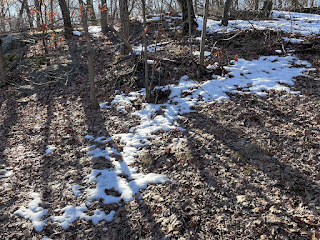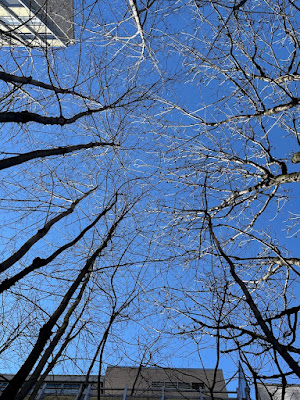Thursday, February 29, 2024
Work in progress
Wednesday, February 28, 2024
Tuesday, February 27, 2024
Lent madness
Without knowing Jesus' inversion of "imperial Roman theology" we might replicate it. The live discussion was with Brian Zahnd, who leads a non-denominational church in Missouri. He hails from the Jesus Movement of the 1970s, and uses Crossan's ideas about the countercultural vision of Jesus' nonviolent path to peace through justice in his preaching and writing (though an editor once asked him if might quote someone else). He uses it in particular in preaching against Christian nationalism. "America is not the biblical Israel," he told us he says, "it's the biblical Babylon." Good stuff!
Sunday, February 25, 2024
Music ministry
Our choir sang today an anthem I've known for decades from a favorite CD of "Music of the English Church," Richard Farrant (1530-80)'s "Lord, For They Tender Mercy's Sake." We didn't sound as good as the Cambridge Singers, but it hardly mattered. What had the congregation all atitter were two of the congregational hymns we've not sung before - "Methodist hymns!" as members of the congregation raised in that tradition delightedly described them. Of one, "Lead Me to Calvary" (below), a fellow lay member of the choir announced with approval: "this is a revival hymn!"
Both were new to me, as have been other hymns from the collection Lift Every Voice and Sing II: An African American Hymnal which our new music director has been introducing us to. Not all these hymns originated in Black churches, but most are American. It's a musical heritage foreign to me in ways the Anglican choral tradition is not. I'm almost embarrassed to confess that I've recognized a few from movies, including the churches (mainly white) in old westerns!
But the appearance of these hymns in our shared life has been hugely important to many who grew up with them. My fellow choir member left the churches of her youth because of their conservatism, winding up in an Episcopal church in Kansas City after looking for a church which offered open communion and equal participation for women in all things. This made theological sense to her but their music was strange and unwelcoming; it felt like a "divorce" from the hymnody she had loved. And our return to it makes her and others glad in ways I can hardly imagine. (I grew up in a Vatican II Catholic church so hymnody was not a strong suit.)
All this makes me aware of how fortunate we are in our music director, who understands his work as "music ministry." His broadening of our range of hymns and anthems has resonated with many in the congregation, and led to discussions of the role and meaning of music in our liturgy we've never had. If the language of revival hymns is in turn challenging to some of us, why do we put up with the endless royalty language in the Anglican hymns?
Saturday, February 24, 2024
Friday, February 23, 2024
Simian simulations
 for yesterday's blogpost I most certainly didn't expect my get this! Or - a little more formally dressed when placed in the library - this:
for yesterday's blogpost I most certainly didn't expect my get this! Or - a little more formally dressed when placed in the library - this:Thursday, February 22, 2024
Darwinian trees
Wednesday, February 21, 2024
Apples and oranges
I'm trying to think something through. If it were a class, I'd make a handout with these quotes and pictures from Darwin's notebooks:
Monday, February 19, 2024
Sunday, February 18, 2024
K-AI-lash
Saturday, February 17, 2024
Friday, February 16, 2024
Tuesday, February 13, 2024
Luminous
Monday, February 12, 2024
Sunday, February 11, 2024
Bumper to bumper
Saturday, February 10, 2024
Friday, February 09, 2024
Thursday, February 08, 2024
Phoneless delight!
This is an idea I got from the poet Ross Gay, who spent a year writing an essay each day about something that delighted him, and then compiled a selection of these pieces into The Book of Delights.
A delight practice is quite simple: you make a point, as you go about your everyday life, to notice things that spark a moment of delight for you.
These could be anything – a beautiful cloud, a pretty flower, or even something funny or absurd. When you encounter it, you raise a finger in the air – and you announce, out loud and enthusiastically, “Delight!” (The out loud part is important, even if you are alone.)
If someone asks you what the heck you are doing, tell them about this practice and invite them to join you.
Wednesday, February 07, 2024
Monday, February 05, 2024
Historic planet
 Returned to "Prehistoric Planet," this time with trees on my mind. The series remains confounding in its uncanny recreation of nature documentary stories and angles in a CGI reconstruction of the late Cretaceous - 66 million years ago. Binge-watching all five episodes of the first season and the first of the new, second season has left me sated and a little sickened at the pervasive anthropomorphism.
Returned to "Prehistoric Planet," this time with trees on my mind. The series remains confounding in its uncanny recreation of nature documentary stories and angles in a CGI reconstruction of the late Cretaceous - 66 million years ago. Binge-watching all five episodes of the first season and the first of the new, second season has left me sated and a little sickened at the pervasive anthropomorphism.

























.jpeg)









.jpeg)